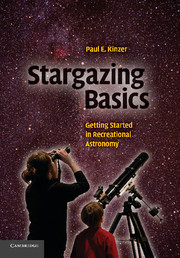Introduction: why another stargazing guide?
Published online by Cambridge University Press: 12 August 2009
Summary
I had been an armchair astronomer for years: I loved reading about science, and I had some general knowledge about the Universe and how it works. However, I knew little about the actual night sky as it appears above the Earth, and I had never owned a decent telescope.
Then, in 1995, I started a nature program for urban nine- to twelve-year-olds. For the program, I bought a good Nikon “spotting scope”: a small telescope made primarily for viewing birds and other Earth-bound objects (see Figure 1). On an overnight camping trip, I aimed the telescope at the Moon, so the kids could see the detail: craters, mountains, and “seas.” The children were amazed, since most of them had never really seen the Moon before. I was impressed, because the telescope gave excellent views: the images were very sharp. But I had seen the Moon through binoculars, and it was familiar enough that it was not as thrilling for me as it had been for the children.
After the kids were asleep in their tents, I used the telescope again. The sky was very dark once the Moon had set, and I looked at fields of stars in the Milky Way for some time. Then I aimed the scope at a bright yellow star. I was not expecting much: stars are so far away that they appear only as sharp points in even the largest telescopes.
- Type
- Chapter
- Information
- Stargazing BasicsGetting Started in Recreational Astronomy, pp. 1 - 4Publisher: Cambridge University PressPrint publication year: 2008



